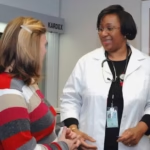For decades cancer has been described as a disease that cannot be transmitted from one person to another. It is a disorder of the body’s own cells—rogue cells that multiply uncontrollably, unbound by the usual rules of growth and repair. But a case that emerged from Germany has challenged this assumption. A surgeon, after performing an operation on a patient with a rare cancer, later developed an identical tumor on his own hand.
At first, this seemed impossible. How could a physician “catch” cancer? Further analysis revealed that the tumor cells in the surgeon’s hand were genetically identical to those of his patient. The case was meticulously verified through molecular studies, and although it remains extraordinarily rare, it has forced scientists to reconsider the boundaries of cancer biology and immune protection. This story is not just about a medical anomaly it is a reflection of how fragile the line can be between healer and healed.
The Astonishing Case: When a Surgeon Became a Patient
The case involved a surgeon who was performing a complex operation to remove a malignant fibrous histiocytoma an aggressive form of soft-tissue sarcoma. During the procedure, the surgeon accidentally cut his palm—a small but critical breach in the sterile barrier that protects doctors during operations. Although he followed protocol by disinfecting the wound, the cut became the starting point of an unexpected biological event.
Five months later, a firm nodule appeared at the exact site of the injury. Biopsy results revealed it was the same rare cancer that had been removed from the patient. Genetic sequencing confirmed that the surgeon’s tumor was not his own but originated from the patient’s cells. According to reports summarized by The Lancet Oncology, this case represented one of the few confirmed examples of direct human-to-human cancer transmission under medical conditions.
| Event | Description | Timeframe |
| Surgery performed | Removal of patient’s malignant fibrous histiocytoma | Day 0 |
| Surgeon injury | Accidental cut on hand during drain placement | Same day |
| Wound healing | Standard disinfection, no infection observed | Week 1 |
| Lump appears | Firm nodule develops at cut site | Month 5 |
| Biopsy result | Identical tumor to patient’s | Month 6 |
| Genetic confirmation | Molecular match of cancer DNA | Month 7 |
| Surgeon’s recovery | Complete removal, no recurrence | 2 years follow-up |
This chain of events brought global attention to an almost unimaginable occurrence—proof that, in vanishingly rare cases, cancer cells can cross from one human to another.
How Cancer Transmission Could Happen
Under normal conditions, cancer cannot be transmitted like a virus or infection. The immune system recognizes any foreign cells and eliminates them quickly. Yet in this case, something unusual occurred. When the surgeon’s skin barrier broke, live tumor cells may have entered the wound. The hand’s tissue environment, rich in blood supply, could have provided temporary protection for the transplanted cells, allowing them to attach and multiply.
Researchers at the National Institutes of Health (NIH) explain that the human immune system is highly efficient at rejecting non-self cells, but tumors sometimes possess mutations that cloak them from immune detection. These “stealth” cells can avoid immune attack and begin dividing, mimicking local tissue. The surgeon’s small wound may have lacked enough immune surveillance at the moment of exposure, granting the cancer cells a brief window to survive.
| Protective Mechanism | Function | Why It Failed Here |
| Skin barrier | Prevents cell entry | Breached by surgical cut |
| Innate immunity | Destroys foreign cells quickly | Localized immune delay |
| Adaptive immunity | Detects and eliminates mutated cells | Tumor cells evaded recognition |
| Cell signaling | Restricts abnormal growth | Hijacked by transplanted tumor cells |
The case reveals that even the body’s complex defenses can falter when conditions align perfectly for a rare biological event.
Breaking Medical Myths: Is Cancer Really Non-Contagious?
The notion that one could “catch” cancer has long been dismissed in medical science. Historically, fears of contagion were based on misunderstanding. In truth, cancers arise from internal genetic mutations, not external pathogens. Yet rare exceptions, like the surgeon’s case, show that under exceptional circumstances, viable cancer cells can survive transfer between individuals.
The World Health Organization (WHO) clarifies that these cases are exceedingly rare and require direct cellular contact, such as transplantation, pregnancy, or severe immune compromise. Mother-to-child transmission and organ-donor-related cancers fall under the same category of rare occurrences. However, these examples underscore that cancer, while not infectious in the usual sense, can—under extreme biological coincidence—transfer between human tissues.
Occupational Exposure and Hidden Surgical Risks
Surgeons operate daily under intense conditions. They face exposure to bloodborne viruses, radiation, and chemical disinfectants. Yet, until recently, the idea of acquiring cancer from a patient was unthinkable. The Mayo Clinic emphasizes that surgical gloves, gowns, and barriers drastically reduce contamination risk, but they cannot guarantee total protection if an open wound exists.
Medical literature shows that sharp injuries occur in up to one-third of all surgical procedures. Although most are superficial, they pose potential pathways for microbial or cellular transmission Surgeon Catches Cancer. This case brings to light the need for heightened awareness of non-infectious biological hazards in surgical environments. Safety now extends beyond infection control—it includes safeguarding against unexpected cellular contamination.
Step-by-Step Timeline of the Case
Understanding how this incident unfolded helps clarify how such rare transmissions are detected and confirmed. Below is a simplified reconstruction of the timeline, correlating clinical and laboratory stages.
| Stage | Clinical Event | Diagnostic Step | Outcome |
| Exposure | Accidental scalpel cut during cancer surgery | Wound cleaned, recorded as minor | No immediate issue |
| Latent phase | Healing period of several months | No visible abnormalities | Surgeon healthy |
| Lesion formation | Firm lump at injury site | Initial imaging and biopsy ordered | Suspicious for malignancy |
| Genetic analysis | Comparison of tumor DNA | Identical genetic profile to patient’s tumor | Confirmed cross-transmission |
| Surgical excision | Removal of lesion | Pathology verified margins clear | Complete recovery |
The diagnostic precision required to identify the genetic identity between tumors highlights the sophistication of modern cancer genomics and forensic pathology.
Genetic Evidence and Scientific Confirmation
In modern oncology, genetic testing is the gold standard for tracing cellular origins. In this case, pathologists conducted microsatellite analysis and DNA fingerprinting, revealing a one-to-one match between the patient’s and the surgeon’s tumor. According to a study discussed in Nature Reviews Cancer, such evidence eliminates coincidence as a possible explanation.
The case also illuminated how certain tumor types, particularly soft tissue sarcomas, can be aggressive enough to survive outside their native environment. Researchers propose that these cells may possess traits similar to stem cells, allowing them to adapt and thrive even after transfer. This event provides valuable data for cancer immunology research, showing how malignant cells circumvent host defense systems under unique conditions.
Treatment Journey and Recovery Process
Once the surgeon’s tumor was diagnosed, immediate action was taken. The affected tissue was surgically removed with clear margins to prevent recurrence Surgeon Catches Cancer. Pathologists confirmed that no residual tumor cells remained. Over the next two years, the surgeon underwent continuous monitoring through imaging and clinical exams, with no further malignancy detected.
What makes this outcome remarkable is the body’s resilience once the foreign tumor was removed. The surgeon’s immune system did not allow further spread, demonstrating how, despite the initial lapse, the body can reclaim control. This recovery reinforces findings from NIH Cancer Research that localized tumors can be completely eradicated when identified early and excised with precision.
What the Case Means for Surgical Protocols
This unprecedented event has led many medical boards to reexamine existing surgical safety standards. Surgeons are now encouraged to implement double-gloving practices, employ thicker protective layers, and replace gloves immediately after any puncture. According to updated guidelines from the Centers for Disease Control and Prevention (CDC), strict post-injury monitoring should follow any cut sustained during cancer-related surgery.
Institutions have also begun emphasizing reporting and documentation. Even minor wounds are now recorded, enabling long-term tracking of potential occupational exposures Surgeon Catches Cancer. While this case is unique, it sets a precedent for how healthcare professionals should approach unforeseen biological hazards.
| Recommendation | Rationale | Implementation Level |
| Double-gloving | Reduces puncture risk | Standard in oncology surgery |
| Immediate disinfection | Eliminates viable cells | Mandatory |
| Exposure documentation | Tracks injury events | Institutional protocol |
| Genetic testing if suspicious lesion forms | Confirms origin | Case-by-case basis |
| Education on rare risks | Improves awareness | Ongoing CME programs |
These measures don’t suggest a widespread risk but serve to reinforce vigilance in high-stakes surgical environments.
The Human Side: Emotional and Psychological Impact
Beyond science lies the deeply personal story of a physician facing the disease he dedicated his life to treating. When a surgeon becomes a patient, the boundaries between professional detachment and emotional vulnerability dissolve. The experience forces a redefinition of empathy. According to Harvard Health Publishing, healthcare providers who experience illness themselves often develop stronger patient communication and compassion afterward.
The emotional journey is Surgeon Catches Cancer. The surgeon had to confront fear, uncertainty, and the profound irony of his situation. Yet, through recovery, he emerged as a symbol of resilience within the medical community. His case reminds practitioners worldwide that healing is not only technical—it is deeply human, woven from shared vulnerability and courage.
What This Event Reveals About Cancer Biology
From a scientific standpoint, this case provides a rare natural experiment on how cancer cells interact with a foreign host. It suggests that tumor cells, under certain conditions, may temporarily mimic stem-cell behavior, integrating into foreign tissues. This finding aligns with emerging studies in Nature that explore cancer cell plasticity—the ability to adapt and reprogram under stress.
Moreover, the event challenges the long-standing belief that immune surveillance is absolute. It shows that immune escape is not merely theoretical but can occur spontaneously in unexpected contexts Surgeon Catches Cancer. For researchers, this opens new avenues in immunotherapy design, where strengthening the immune system’s early detection of foreign cells could prevent similar occurrences in future.
Preventive Measures and Future Guidelines
In light of this event, surgical and research communities have developed enhanced guidelines to mitigate the already negligible risk of cancer transmission. The focus is now on prevention through better barrier integrity, real-time monitoring, and institutional awareness.
The World Health Organization recommends a layered approach to occupational safety: combining protective equipment, procedural training, and post-exposure follow-up Surgeon Catches Cancer. Hospitals are also urged to integrate molecular surveillance into occupational health systems, ensuring that any post-injury abnormalities are swiftly investigated. These improvements protect not only medical professionals but also the integrity of surgical practice itself.
Conclusion: Lessons for the Future of Medicine
The story of the surgeon who caught cancer from his patient is a reminder that medicine remains a field of constant learning. It teaches humility—no matter how advanced our knowledge becomes, nature still holds surprises. The event is not cause for alarm but a call for curiosity, reminding us that science progresses through exceptions, not assumptions.
For patients, it reassures that such transmissions are virtually impossible outside rare medical accidents. For doctors, it is a lesson in diligence, safety, and respect for the microscopic boundaries that define life Surgeon Catches Cancer. Ultimately, this case reaffirms the shared humanity between patient and physician—a bond that drives every discovery and every recovery in modern medicine.
Frequently Asked Questions
Q1: Can someone catch cancer through casual contact or medical care?
No. Cancer cannot spread through touch, air, or proximity. Only in rare medical circumstances involving direct transfer of living tumor cells has such a transmission occurred.
Q2: How did the surgeon’s case change medical safety standards?
It prompted hospitals to review surgical injury protocols, emphasizing rapid response, wound documentation, and protective measures in oncology operations.
Q3: Are some cancers more capable of transmission than others?
Yes, but only in specific laboratory or transplant conditions. Aggressive tumors like sarcomas may survive longer outside the body, but the risk remains exceedingly low.
Q4: What role does the immune system play in preventing such events?
The immune system typically destroys foreign cells immediately. Only if it is bypassed—through injury or immune evasion—could transplanted cells survive briefly.
Q5: What is the global significance of this case?
It reinforces the value of ongoing research in immune defense and occupational safety, ensuring that medical progress continues without compromising the well-being of those who deliver care.







